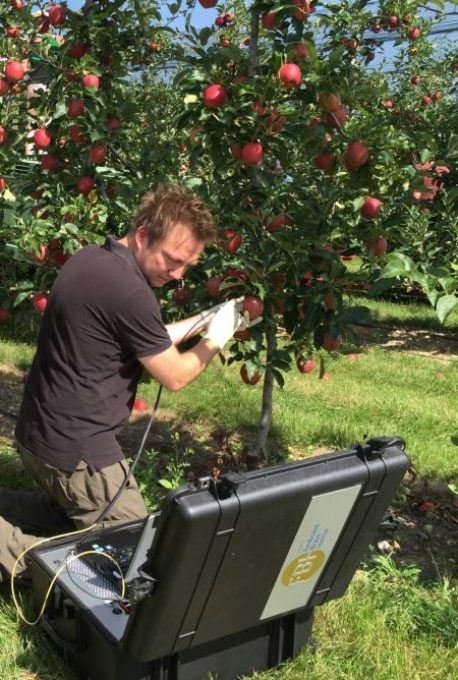Nov 21 2016
Researchers from Ferdinand Braun Institute (Berlin, Germany) have successfully demonstrated a portable shifted excitation Raman difference spectroscopy (SERDS) system in a Swiss apple orchard. This type of system is usually limited to the laboratory bench, in part because it is difficult to move the sensitive setup with precision laser sources and spectrometers into harsh environments. However, the main problem is background sunlight and even fluorescence from the sample. The researchers showed how to overcome the radiation issues using SERDS.
 A portable SERDS system developed by researchers at Ferdinand Braun Institute was tested on an apple orchard in Switzerland. Courtesy FBH
A portable SERDS system developed by researchers at Ferdinand Braun Institute was tested on an apple orchard in Switzerland. Courtesy FBH
Raman spectroscopy is an excellent method to identify the molecular fingerprint of many substances: Be it explosives on the airport, cancer cells in the operating theatre or not-so-fresh steaks in the supermarket--they are all characterized by a Raman spectrum of key components. The method is label-free, nondestructive with sub-micron spatial resolution, and particularly useful for biomedical applications.
In SERDS, two Raman spectra are recorded, each excited with a wavelength-stabilized single-mode laser. The wavelength of a second laser is just slightly shifted and so is the Raman spectrum. By subtracting each Raman spectra both the background radiation and fluorescence can be eliminated. After integration of the difference spectrum, the resulting Raman spectrum has a signal-to-background noise ratio that is more than one order better than the measured Raman spectra.
The SERDS system from the Ferdinand Braun Institute is based on a dual-wavelength laser diode. The handheld probe is the size of a laser pointer and emits laser light at approximately 785 nm. The chip in the center alternates between two wavelengths with a separation of 0.62 nm (10 cm-1), which is about the typical width of relevant Raman peaks. The probe excites the Raman spectra with a power up to 120 mW. The radiation from the object is collected by a high-NA lens and sent to a handheld spectrometer via fiber optics. The spectrometer, the diode power supply, and a battery are stored in a protectve case and the results are displayed on a rugged laptop.
Field test in precision agriculture
Development of this sensor system was funded within a German research program as part of a European program for agricultural research. One of the funding aims is the development of tools for precision agriculture, where fertilizing is dependent on the intra-field variability in crops. With this in mind, the system was field-tested at an apple orchard in Switzerland. Apples and apple leaves were chosen for SERDS measurement. On the fruits the signature spectrum of the thin wax layer on the surface was determined. The tests with an integration time of one second showed successful background reduction from ambient daylight.
Apple leaves were tested on the tree. The spectra showed strong fluorescence from the chlorophyll together with background signals from daylight. Accordingly, the single accumulation time was reduced to 0.2 s to avoid saturing the detector. By subtracting both Raman spectra, the Raman lines of interest became clearly separated from both interferences.
Based on these field tests the researchers believe that the portable SERDS system is suitable for other rapid outdoor Raman investigations, and several partners have already shown interest in further development.